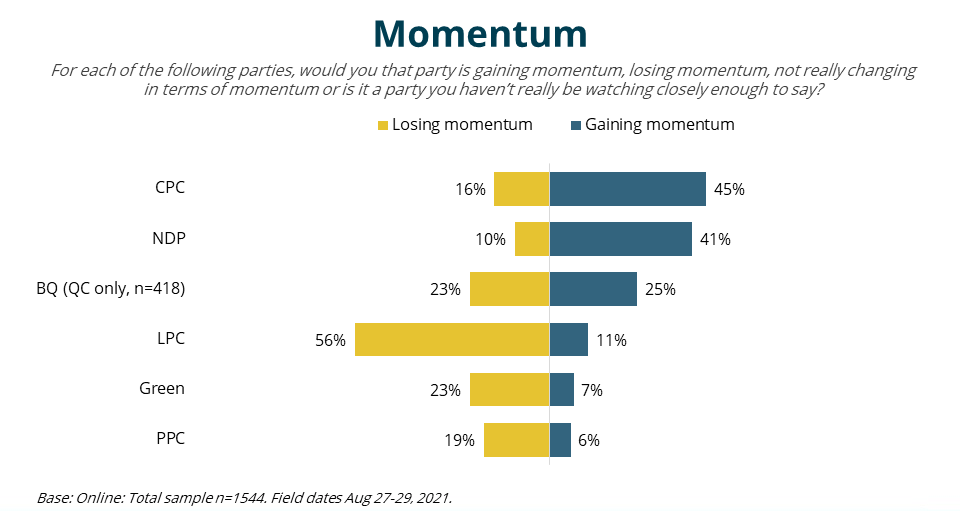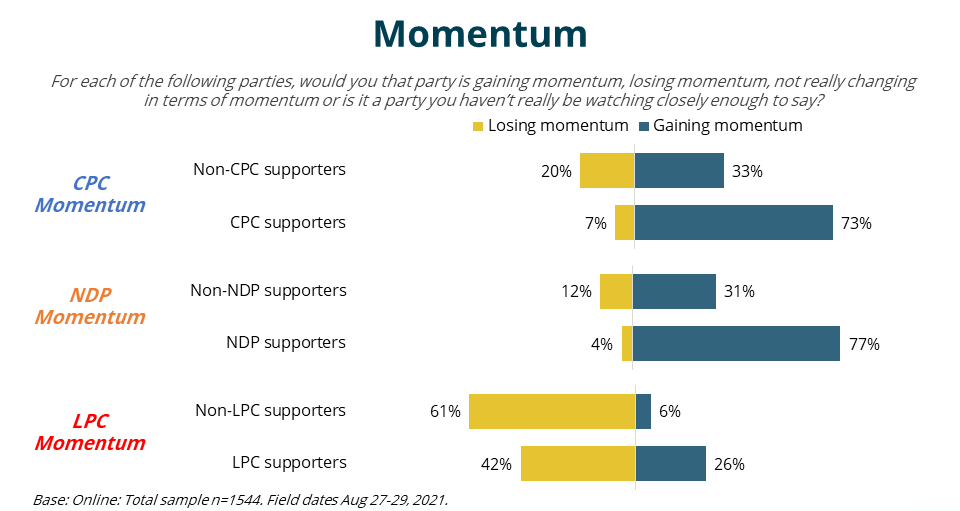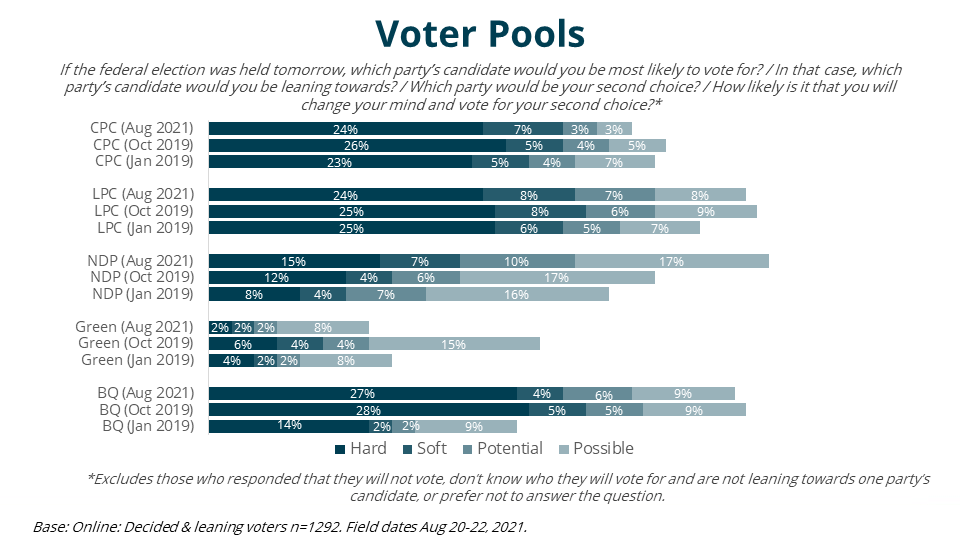Conservatives, NDP have momentum while Liberal support slips
Last week, we noted that the slight changes in support for the three major national political parties, while not particularly significant on their own, would be more meaningful if they signaled a longer-term trend. As it turns out, these shifts in national popular vote have continued and may have accelerated. Two parties, in particular, are on the rise in our research, largely at the expense of one party.
Over the past week, Conservative support has risen four more points to 34%. NDP support also continues to trend upward, from 21% to 24% in our most recent study. Meanwhile, Liberal support is now at 30%, compared to 33% last week.
When compared to the results we found at the outset of the campaign only two weeks ago, we have seen the Conservative share of decided and leaning vote increase by 5%, the NDP increase 4% and the Liberal share dropping 6% nationally.
Turning to the regional races, Ontario and Quebec are looking increasingly competitive. In Ontario, the Liberals and Conservatives are essentially tied (35% and 34% respectively) while the NDP slightly up now, into the mid-20s. In Quebec, Liberal support has fallen from 34% to 29%, leaving them statistically tied with the BQ at 28%. Of note, both the CPC and the NDP have made gains in Quebec. The CPC is up three points to 21%, and the NDP up 6 points to 17%. The NDP has also made gains in BC and is now leading in that province with 35% support, followed by the Liberals at 31% and the CPC at 28%.

Among those who feel there has been any sort of shift in each of the parties’ momentum after two weeks of campaigning, more agree that the CPC and NDP are, on balance, gaining momentum, while the Liberals are losing it. Asked whether the parties are gaining, losing or haven’t changed in terms of momentum, almost half (45%) say the CPC are gaining, while 41% say the NDP are gaining. While voters who do not support either of these parties are a bit less inclined to believe they are building momentum, they are still more likely to believe they are gaining than losing. A third (33%) of non-CPC supporters see momentum building for the party, compared to 20% who see it waning. Slightly less than a third of non-NDP supporters (31%) believe that party’s momentum is growing, compared to just 12% who feel it shrinking. There is potential for both parties to build on their current levels of support by virtue of being seen among those who do not currently intend to vote for them as gaining energy.
In contrast, just 11% of voters feel the LPC is gaining, and over half (56%) believe they are losing momentum. Even among LPC supporters, more feel the party is losing (42%) than gaining (26%).


Shifting Voter Pools and Second Choice Support
Last week, we presented results related to second-choice support. This week, we’ve analyzed that data further a developed a series of voter pools* for each party. We then compared the results to research we did ahead of the 2019 federal election.
The CPC and LPC voter pools are fairly stable from 2019 to present. However, the NDP has seen its hard vote (the % who say a party is their first choice and are unlikely to change their vote) grow from 8% in January 2019, to 12% in October 2019, to 15% currently. Their pool has also grown overall, up from 35% to 49%. Notably, it is the largest voter pool among all the parties.

*Definition of voter pool categories.
a. “Hard” voters say party X is their first choice and are less than somewhat likely to change their vote
b. “Soft” voters say party X is their first choice but are at least somewhat likely to change
c. “Potential” voters say party X is their second choice and are at least somewhat likely to change
d. “Possible” voters say party X is their second choice but are less than somewhat likely to change
Tracking second choice support also suggests that there are different dynamics at play in this election as Canadians consider which party to support. First, the percentage who would select the CPC as their second choice has shrunk to just 6%, likely driven by a collapse in second-choice support among current Liberal voters. In January 2019, 22% of Liberal supporters named the CPC as their second choice, falling to 16% in October of that year. Now, just 2% would support the CPC, while over half (58%) give their second-choice support to the NDP.
We also note the significant fall in Green Party second-choice support overall, down from 19% in October 2019 to 10%.
Finally, BQ voters are basically no longer inclined to name the Liberals as their second choice today, whereas there was some inclination to do so in 2019. Just 1% currently name Liberal as their second choice, compared to 16% in October 2019.

This survey was sponsored by Earnscliffe Strategy Group and conducted by Leger using a random sampling of panelists from Leger’s proprietary online panel. The survey was conducted with 1,544 individuals from across Canada between August 27 and 29, 2021. The data was weighted to be reflective of the Canadian population by age, region, gender, education and mother tongue (QC only, FR vs non-FR) based on 2016 Census data. Since this survey was conducted using an online panel, no margin of error may be calculated.Earnscliffe follows the CRIC Public Opinion Research Standards and Disclosure Requirements that can be found here: https://canadianresearchinsightscouncil.ca/standards/

View the survey questionnaire | Download the full data tables
